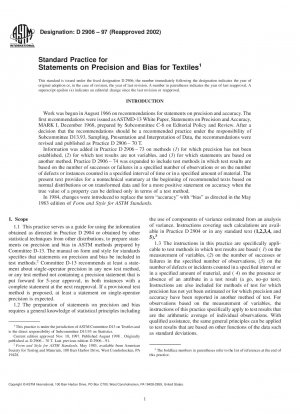ASTM D2906-97(2002)
Standard Practice for Statements on Precision and Bias for Textiles
- Standard No.
- ASTM D2906-97(2002)
- Release Date
- 1997
- Published By
- American Society for Testing and Materials (ASTM)
- Status
- 2008-08
- Latest
- ASTM D2906-97(2002)
- Scope
1.1 This practice serves as a guide for using the information obtained as directed in Practice D 2904 or obtained by other statistical techniques from other distributions, to prepare statements on precision and bias in ASTM methods prepared by Committee D-13. The manual on form and style for standards specifies that statements on precision and bias be included in test methods. Committee D-13 recommends at least a statement about single-operator precision in any new test method, or any test method not containing a precision statement that is put forward for 5-year approval, in both instances with a complete statement at the next reapproval. If a provisional test method is proposed, at least a statement on single-operator precision is expected.
1.2 The preparation of statements on precision and bias requires a general knowledge of statistical principles including the use of components of variance estimated from an analysis of variance. Instructions covering such calculations are available in Practice D 2904 or in any standard text (1,2,3,4, and 5).
1.3 The instructions in this practice are specifically applicable to test methods in which test results are based ( 1) on the measurement of variables, (2) on the number of successes or failures in the specified number of observations, (3) on the number of defects or incidents counted in a specified interval or in a specified amount of material, and ( 4) on the presence or absence of an attribute in a test result (a go, no-go test). Instructions are also included for methods of test for which precision has not yet been estimated or for which precision and accuracy have been reported in another method of test. For observations based on the measurement of variables, the instructions of this practice specifically apply to test results that are the arithmetic average of individual observations. With qualified assistance, the same general principles can be applied to test results that are based on other functions of the data such as standard deviations.
1.4 This standard includes the following sections:
Section No. Attributes, Statements Based on 15 Binomial Distributions, Calculations for 9 Binomial Distributions, Statements Based on 13 Categories of Data 7 Computer Preparation of Statements Based on Normal or Trans-formed Data 12 Normal Distributions and Transformed Data, Calculations for 8 Normal Distributions and Transformed Data, Statements Based on 11 Poisson Distributions, Calculations for 10 Poisson Distributions, Statements Based on 14 Precision and Bias Based on Other Methods 16 Precision Not Established, Statements When 17 Ratings, Statements Based on Special Cases of 18 Sources of Data 6 Statistical Data in Two Sections of Methods 5 Significance and Use 4
ASTM D2906-97(2002) Referenced Document
- ASTM D123 Standard Terminology Relating to Textiles*, 2023-09-14 Update
- ASTM D2904 Standard Practice for Interlaboratory Testing of a Textile Test Method that Produces Normally Distributed Data
- ASTM D2905 Standard Practice for Statements on Number of Specimens for Textiles
- ASTM E456 Standard Terminology for Relating to Quality and Statistics
- ASTM E691 Standard Practice for Conducting an Interlaboratory Study to Determine the Precision of a Test Method*, 1999-04-19 Update
ASTM D2906-97(2002) history
- 1997 ASTM D2906-97(2002) Standard Practice for Statements on Precision and Bias for Textiles
- 1997 ASTM D2906-97 Standard Practice for Statements on Precision and Bias for Textiles
